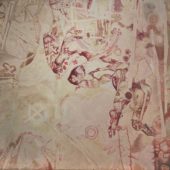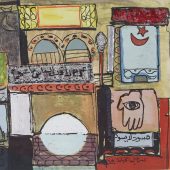Ismail Khayat
- Country: Iraq
- Exhibitions:
- Chefs-D’œuvre de L’art Moderne et Contemporain Arabe
- Hurufiyya
- RE: Orient
Combining Kurdish folklore and symbolism, the artwork of Ismail Khayat encodes ideas of collective struggle and political isolation. Born in Khanaqin, northern Iraq, Khayat is an inspirational figure among Kurdish intellectuals and artists. Rendered in a naïve style, Khayat’s mixed-media collage Those Who Watch Other People Will Die of Envy (1965) observes superstitions surrounding the evil eye citing common expressions and symbols from the Middle East and North Africa.
Khayat illustrates a hamsa, an emblem containing a right hand with an eye, and confronts the viewer with the artwork’s Arabic title, questioning their moral judgement and gaze. Representations of birds as metaphors for freedom and the fragility of life are recurrent themes in Khayat’s artwork. Referencing Kurdish and Iraqi folklore, he investigates the progressive socio-political isolation of Iraq’s Kurdish population. In a series commemorating former President Saddam Hussein’s notorious Al Anfal campaign, which used chemical weapons on Kurdish cities and destroyed some 2,000 villages in the late 1980s, Khayat depicts abstracted phantom-like birds flying away from dead bodies.
The artist joined the Society of Iraqi Plastic Arts in 1965 before graduating from the Teachers College at Baquba in 1966. In 1992, he became art director at the Ministry of Culture in the Kurdistan Region.
Related artists by country
- Ahmed Alsoudani
- Ayad Alkadhi
- Dia Azzawi
- Faisal Laibi Sahi
- Halim Al Karim
- Hanaa Malallah
- Hayv Kahraman
- Kareem Risan
- Layla Al Attar
- Nedim Kufi
- Shakir Hassan Al Said
- Suad Al-Attar
- Hafidh Al Droubi
- Ismail Fattah
- Kadhim Hayder
- Saadi Al Kaabi
- Nouri Al Rawi
- Issam Al Said
- Hassan Massoudy
- Jamil Hamoudi
- Rafa Al Nasiri
- Amer Al Obaidi
- Hani Mazhar
- Hanoos Hanoos
- Maysaloun Faraj
- Sinan Hussein
- Amar Dawood
- Nazar Yahya
- Athier
- Ali Talib
- Mahmoud Obaidi
- Khadeir Al Shakarji
- Ali Al Tajer
- Mahmoud Abboud Fahmy
- Ghassan Ghaib
- Jewad Selim
- Salman Al Basri
- Modhir Ahmed
- Salman Abbas
- Sadik Alfraji
- Tawfik Al Alousi
- Ismael Al Sheikhly
- Sama Al Shaibi
- Adel Abidin
- Afifa Aleiby
- Saadi Al Saffar
- Michael Rakowitz
- Abdul Qadir Al Rassam
- Athar Jaber
- Lorna Selim
- Nabil Safwat
- Nadia Osi
- Faraj Abbo Al Numan
- Khaled Al Jader
- Madiha Umar
- Mahmoud Sabri
- Faik Hassan
- Saleh Al Jumaie
- Atta Sabri
- Jananne Al-Ani
- Abdul Qadir Al Obaidi
- Haidar Al-Mehrabi
- Baghdad Benas
- Naziha Selim
- Rajiha Qudsi
- Nadira Azzouz
- Widad Orfali
- Zaha Hadid
- Latif Al Ani
- Mahood Ahmed
- Mohammed Ghani Hikmat
- Nuha Radi
- Siham Al Saudi
- Suha Sharif Yousif
- Wasmaa Khalid Chorbachi

